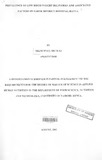| dc.description.abstract | World Health Organization defines low birth weight as weight at birth of less than 2,500 grams. Low birthweight infants contribute greatly to disability adjusted life years in developing countries and place great strain on budgets of poor economies like Kenya. Health staff in Narok District Hospital had raised concern about increased low birth weight deliveries while the problem was under-reported in medical reports. The. main objective of the current study was to determine prevalence of low birth weight deliveries at Narok District Hospital and associated factors amenable for intervention.
A cross-sectional descriptive study was done in the months of September and October 2011 on all live births delivered at the hospital. Anthropometric measurements of the mother and newborn were taken within 48hours of delivery and recorded in a pre-tested semi-structured questionnaire. Data on demographic and socio-economic characteristics, morbidity and feeding practices were obtained from medical records and interviews with the mothers. Chi-square and logistic regression were the main statistical measures used for testing association of the dichotomous (low and normal birth weight) outcome and presumed determinant factors.
A total of 348 live births were studied. The prevalence of low birth weight of 16.4% was significantly higher than the national estimate of 8% and the local estimate of 7.1 %. Bivariate analysis showed significant association (P<0.05) between birth weight and age of the mother (P=0.032), circumcision status of the mother (P=0.025), mother's education level (P=0.002), father's education level (0.014), household size (P=0.003), residence (P=0.044), household income (P=0.003), amount of money spent on food (P=0.003), food avoidance by the mother (P=0.002) and number of antenatal care visits (P=O.OOO).
Logistic regression showed significant association between low birth weight (P<O.05) and mothers' religion (p=O.017), Weight (P=O.045), gestation period (P=O.OOO) and plurality (P=O.OOO). Higher maternal weight and Christian faith were protective factors against low birth weight, while lower gestation period and plurality were risk factors for neonatal low birth weight. Conversely, higher maternal weight was significantly associated (P<O.05) with maternal
Christian faith (P=O.015) and non-Maasai ethnicity (P=O.OOO). Circumcised mothers also, had significantly lower mean weight (P=O.OOO) compared to their uncircumcised counterparts.
The study concludes that the prevalence of low birth weight is higher than the local estimate and exceeds the 15% thresh hold that indicates a public health problem. A multipronged approach is required to scale up interventions to address the myriad factors associated with low birth weight especially in the areas of maternal nutrition, harmful cultural practices, health seeking behaviours and mainstreaming nutrition in poverty reduction to break malnutrition cycle. | en |

